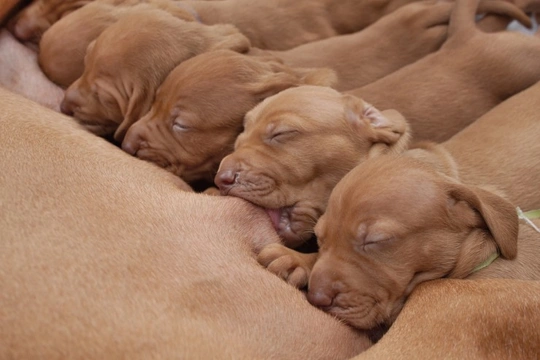
Lactation problems to look out for when caring for a nursing dam
Dogs have been raising their own young quite successfully and without the need for human assistance for millennia, but problems with lactation and nursing are reasonably common in dams raising a litter. Ensuring that the dam produces enough milk to feed all of her pups and supplementing it if necessary is perhaps the most common issue that dog breeders are aware of, but there are a number of different health issues and complications that can lead to a failure to produce enough milk, or feed the pups appropriately that you need to be aware of.
If you already own a pregnant or nursing dam or if you are thinking of breeding from your own dog and are doing your research, it is wise to familiarise yourself with some of the most common lactation problems that can arise in a nursing dam.
In this article, we will cover some of the most common lactation issues in nursing dogs, and outline how to spot that something is amiss and what to do about it. Read on to learn more.
The milk fails to descend
In the period of time before you dam gives birth, her teats will become noticeably larger, darker and more swollen in preparation for feeding her new pups. Before she produces the milk that will sustain the pups for their first few weeks of life, she produces colostrum, a thinner and very nutrient-rich fluid that gives the pups everything they need from their first few meals.
This process is known as the milk descending, and it is triggered naturally by the hormones of the dam’s body as the time of delivery draws closer. However, it is rare but not unheard of for the dam’s milk to fail to descend, which may occur due to a hormonal imbalance, or due to something that happens leading up to and during the delivery itself. Stress, caesarean delivery and other external factors can all increase the risk factors that result in milk failing to descend.
If this occurs, your vet may need to give your dam a hormone injection to trigger the descent of the milk, and you should contact your vet immediately and ask them to attend if the dam isn’t producing colostrum or milk to feed the pups.
Eclampsia
Eclampsia or milk fever occurs when the dam’s body doesn’t produce or maintain high enough levels of calcium during pregnancy and nursing. This leads to a range of symptoms in the dam as well as problems with lactation and nursing, including tremors, weakness and lethargy, and lack of interest in the pups. Left unchecked, eclampsia can also cause fits, laboured breathing and a high temperature.
Again, you will need to let your vet know ASAP if something is amiss, and if eclampsia is diagnosed, you will need to hand-rear the pups for as long as it takes for the dam’s calcium levels to be returned to normal via supplements your vet will provide, and for milk production to resume.
Mastitis
Mastitis is a glandular infection that can affect one or more teats, and that occurs when bacteria travels up the milk ducts through the glands, causing an infection.
When this occurs, the dam will feel generally under the weather, which can lead to lethargy and an unwillingness or inability to feed her pups. The affected teats will usually be inflamed, sore and painful, and the dam will be reluctant to nurse pups on those teats, even potentially becoming aggressive.
Mastitis may be accompanied by a foul discharge from the affected teats, which will often smell rank as well as looking nasty.
In order to treat mastitis, your dam will need antibiotics to clear up the infection and the application of warm compresses to the affected teats to encourage the milk glands to drain the remaining infection and resume normal milk production.
Low milk production
Some dams don’t produce enough milk to feed all of their puppies, particularly if the dam is outside of optimum breeding age or if she has a particularly large litter. If the dam is attempting to feed all of her pups and is clearly producing milk, it can be hard to tell if this is the case, so you will need to keep a careful eye out.
When milk production is low, the stronger and more outgoing puppies will usually fare the best, pushing weaker pups out of the way when feeding. Weighing and monitoring the growing pups daily whilst they are very young is one of the best ways to ensure that they are all thriving and growing at the appropriate rate, and can help you to identify any problems such as low milk production.
If your dam doesn’t seem to be producing enough milk or if her milk dries up too soon, the pups may need supplemental feeding, so again, contact your vet.
Sore teats
The number of teats a dam has can be quite variable, and not all of them will necessarily produce the same amounts of milk. This means that all of the pups may keep returning to the same teats to nurse, and if there are only a small number of teats in use, those teats are more likely to become sore as a result.
This will of course be painful for the dam as well as raising the risk of infection setting in, further reducing the viable teats and milk production. Once more, ask your vet to check out the dam and suggest solutions, which may once more mean that supplemental feeding of the pups is required.



